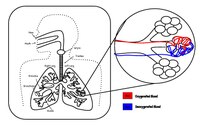
Photo from wikipedia
This paper presents a cost-effective and reliable diffusion-based humidity removal membrane for microfluidic-based gas analyzers. The developed humidity control device reduces the relative humidity of a gas chamber and also… Click to show full abstract
This paper presents a cost-effective and reliable diffusion-based humidity removal membrane for microfluidic-based gas analyzers. The developed humidity control device reduces the relative humidity of a gas chamber and also stabilizes the humidity using inexpensive inorganic salts. A 3D-printed microfluidic gas sensor is used to test four different volatile organic compounds (VOCs) including three alcohols and one ketone in different relative humidity levels ranging from 15% to 80%. To study the effects of humidity on different features of the transient response of the sensor, two different feature extraction methods are used. These methods are (i) normalization method, removing the effect of any changes in the response level for identifying the nature of the gas, and (ii) integration method, which differentiates between different response levels due to different concentrations or humidity levels. The results show that the sensor fails to differentiate between different VOCs or even between different concentrations of the same gas when there is a slight change (as small as 5%) in humidity. In essence, the device is vulnerable to the errors occur due to the presence of humidity even after the post processing analysis (feature extraction). Thus, a humidity control and removal membrane is developed in order to minimize the effect of humidity. The selectivity of the sensor with and without the use of the humidity removal membrane is compared and shown to be 36% more in the case of utilizing the humidity removal membrane. The proposed humidity control system successfully removes the effect of humidity on the response pattern of the sensor and can be used for different applications such as breath analyzers for which lowering the level of humidity of the exhaled breath is crucial before analyzing the VOCs of interest.
Journal Title: Analytica chimica acta
Year Published: 2018
Link to full text (if available)
Share on Social Media: Sign Up to like & get
recommendations!